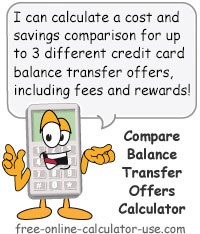IMPORTANT: Numeric entry fields must not contain dollar signs, percent signs, commas, spaces, etc. (only digits 0-9 and decimal points are allowed).
Click the Terms tab above for a more detailed description of each entry.
Step #1:
Enter the amount of the transfer, select your monthly payment method (enter payment amount if fixed), and enter your monthly cash back qualifying purchases.
Step #2:
For each transfer offer you want to compare, enter the offer name and complete the offer's applicable fields. Then tap the "+" ("Add", or "Add Offer") button to add the offer to the list.
Step #3:
After all of the offers are entered, tap the "Compare Transfer Offers" button. This will populate the "Transfer Offer Comparison Chart," plus display a summary and a bar chart showing the net-cost differences between the entered offers.


Follow me on any of the social media sites below and be among the first to get a sneak peek at the newest and coolest calculators that are being added or updated each month.